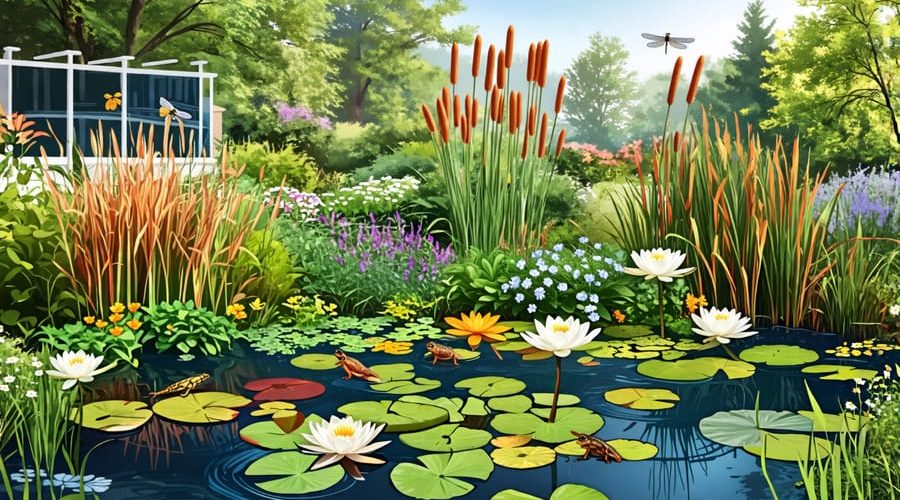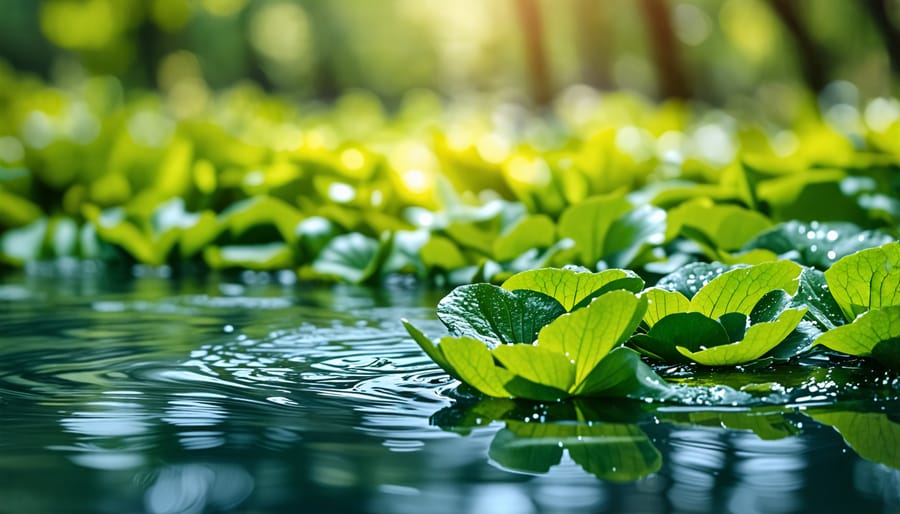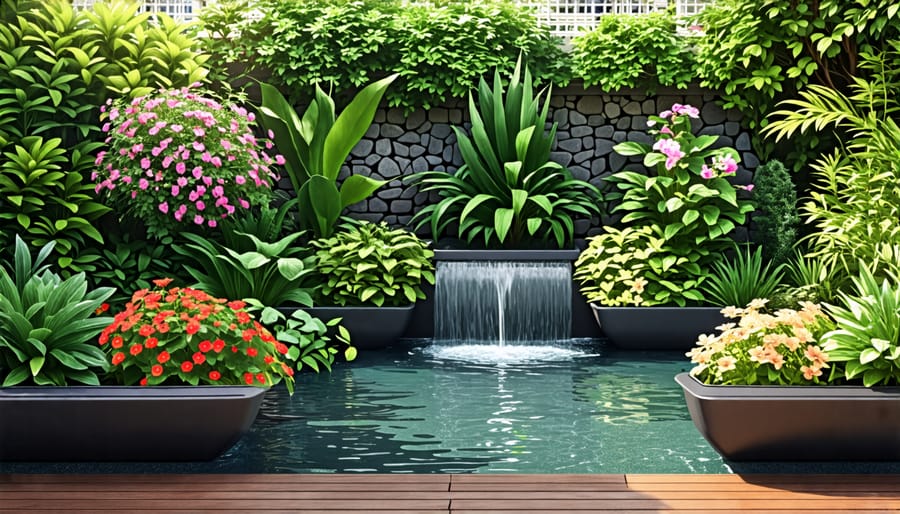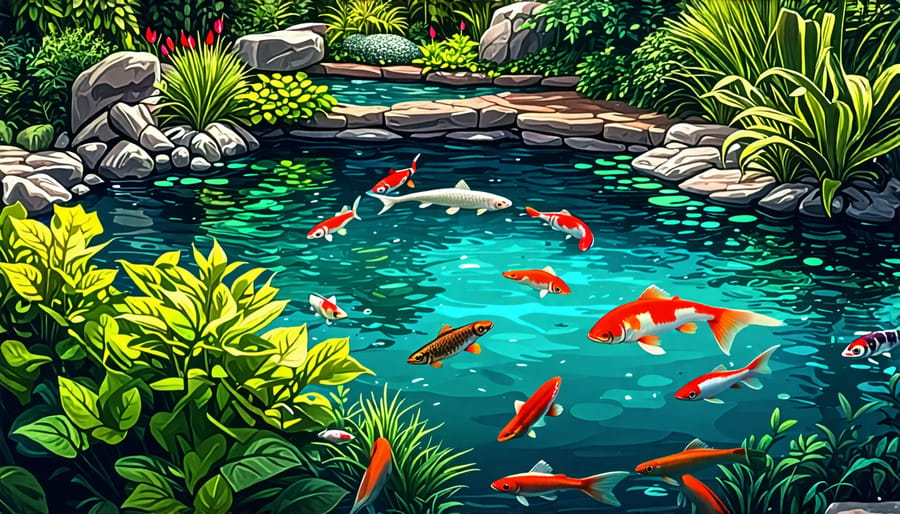
5 Ingenious Ways Your Water Garden Can Help Save the Planet
Plant native species adapted to your local climate to reduce water needs and support biodiversity. Native plants have evolved to thrive in regional conditions.
Build healthy, living soil by adding organic matter like compost. Rich soil retains moisture, reducing irrigation requirements during dry spells.
Mulch planting beds with natural materials like wood chips or pine straw. A thick mulch layer insulates soil, conserves water, and suppresses weeds.
Install a rain barrel to capture roof runoff for watering during droughts. Collecting free rainwater builds resilience to water restrictions and shortages.
Natural Filtration Systems
Top Aquatic Plants for Filtration
Water gardens not only provide a beautiful aquatic oasis, but strategically chosen plants can also create a natural filtration system, improving water quality and clarity. Submerged plants like hornwort, anacharis, and cabomba absorb excess nutrients, preventing algae growth. Floating plants such as water lettuce and water hyacinth shade the water surface while their dangling roots filter out debris. Marginal plants like cattails, rushes, and pickerelweed stabilize pond edges and extract pollutants. For an eye-catching addition, consider water lilies, which provide surface coverage and compete with algae for nutrients. Experiment with a diverse mix of species to create a thriving, self-sustaining ecosystem that naturally purifies your pond. By harnessing the power of aquatic plants, you can enjoy a crystal-clear water feature while contributing to a more sustainable and resilient environment. Embrace the beauty and benefits of these living filters and watch your water garden flourish with minimal maintenance. With a little research and planning, you can create a stunning aquatic display that not only enhances your outdoor space but also supports a healthier, more balanced pond habitat. Start your journey towards a naturally filtered water garden today and enjoy the rewards for years to come.

Encouraging Beneficial Bacteria Growth
To encourage beneficial bacteria growth in your pond, start by adding a variety of aquatic plants. Submerged plants like hornwort and anacharis provide surface area for bacteria to colonize, while floating plants such as water lettuce and water hyacinth shade the water and absorb excess nutrients. Introduce barley straw, which slowly decomposes and supports beneficial bacteria populations. Consider adding a biological filter media, like lava rock or ceramic noodles, to your filtration system. These porous materials house bacteria that break down waste. Maintain a balanced ecosystem by avoiding overfeeding fish and limiting the use of chemical treatments. With these steps, you’ll cultivate a thriving community of beneficial bacteria that keep your pond water clear and healthy.
Rainwater Harvesting
Water gardens offer a beautiful and practical solution for collecting and storing rainwater, reducing strain on municipal water systems while providing a sustainable source for irrigation. By designing your water garden to capture rainfall, you can create a self-sustaining oasis that not only enhances the aesthetics of your outdoor space but also contributes to environmental conservation.
To start, consider the layout and contours of your garden. Strategically place your water garden in an area that naturally collects runoff during rain events. You can further optimize water collection by directing downspouts and creating gentle slopes that guide water towards your pond.
Incorporate aquatic plants that thrive in fluctuating water levels, such as cattails, rushes, and water lilies. These plants not only add visual interest but also help filter the collected rainwater, improving its quality for irrigation purposes. As the water level rises during rainfall, excess water can be channeled to surrounding garden beds, providing a natural and efficient watering system.
To maximize water storage capacity, consider adding a hidden reservoir beneath your water garden. This can be achieved by excavating a deeper section and lining it with a waterproof membrane. The stored water can then be gradually released to maintain pond levels during dry periods, reducing the need for supplemental watering.
By embracing rainwater harvesting techniques in your water garden design, you can create a resilient and sustainable ecosystem that supports local biodiversity while minimizing your environmental impact. With a little creativity and planning, your water garden can become a model of climate resilience, inspiring others to adopt similar practices in their own outdoor spaces.


Supporting Local Ecosystems
Attracting Pollinators and Beneficial Insects
Attracting pollinators and beneficial insects to your pond is not only great for the ecosystem, but also adds vibrant beauty to your water garden. Consider planting native species like bee balm, coneflowers, and milkweed around the edges of your pond. These colorful blooms provide nectar and pollen for bees, butterflies, and hummingbirds. Incorporating shallow areas or planting shelves in your pond design allows these helpful critters to easily access the water. You can also add floating plants like water lilies, which offer a perfect perch for dragonflies and damselflies – natural predators that help control mosquito populations. By creating an inviting oasis for pollinators and beneficial insects, you’re supporting biodiversity and enjoying the lively charm they bring to your backyard haven.
Providing Sanctuary for Amphibians and Reptiles
Water gardens provide vital sanctuaries for threatened amphibians and reptiles facing habitat loss due to climate change and human development. By incorporating features like shallow ledges, hiding spots, and native aquatic plants, your pond can offer a safe haven for frogs, salamanders, turtles, and more. These creatures play crucial roles in maintaining ecological balance, and your water garden can contribute to their conservation. Planting a diverse array of native vegetation in and around your pond creates a hospitable environment that attracts beneficial insects, which in turn support thriving amphibian and reptile populations. By providing a refuge for these vulnerable species, your water garden becomes a small but mighty example of climate resilience in action.
Urban Heat Island Mitigation
Water features like ponds, fountains, and streams can help mitigate the urban heat island effect, where cities experience higher temperatures than surrounding areas due to heat-absorbing surfaces and reduced vegetation. Through evaporation, water features cool the air around them, creating a refreshing microclimate that benefits both people and wildlife.
As water evaporates from the surface of your pond or fountain, it absorbs heat from the surrounding air, effectively lowering the temperature in the immediate vicinity. This natural cooling process can make your outdoor space more comfortable during hot summer days and even reduce the need for air conditioning in nearby buildings.
Moreover, the presence of water attracts birds, butterflies, and other wildlife, which can further contribute to a thriving ecosystem in your backyard. By providing a source of water and a cooler environment, you’re creating a haven for local fauna and helping to counteract the negative effects of urban heat islands.
Incorporating water features into your landscaping not only enhances the aesthetic appeal of your outdoor space but also contributes to climate resilience on a local scale. By taking steps to mitigate the urban heat island effect, you’re doing your part to create a more sustainable and comfortable environment for yourself and your community.
Conclusion
In conclusion, by implementing these climate-resilient water gardening practices, you can create a beautiful and sustainable outdoor space that benefits the environment. From using native plants and reducing water usage to promoting biodiversity and improving water quality, these techniques demonstrate how small changes can make a big impact. As you embark on your water gardening journey, remember that every pond, rain garden, or water-wise plant choice contributes to a more resilient future. By sharing your knowledge and inspiring others to adopt these practices, together we can create a network of thriving, climate-resilient water gardens that support our planet’s well-being. Start today and enjoy the rewards of a sustainable and stunning water garden!
